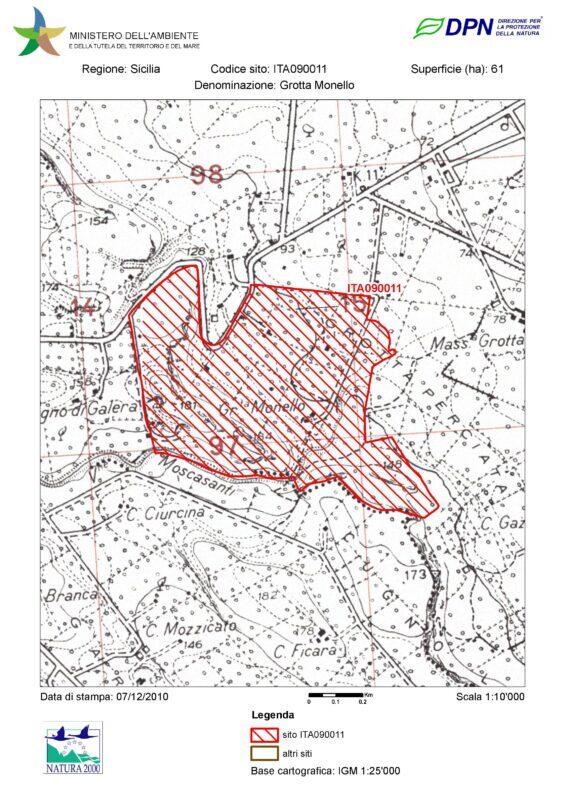ZSC Grotta Monello (ITA090011)
Site type: SAC - Special Conservation Area
Code: ITA090011 - Hectares: 61
Description:
Inside the site falls a karst cave characterized by a small opening, located in a cultivated area. Geologically it is affected by limestone
Miocene with more or less flat surfaces furrowed river valleys called quarries and rocky ridges. The area falls within the bioclimatic belt
subhumid thermo-Mediterranean. Currently the area is characterized by extensive areas cultivated with cereals or tree species such as olive and almond trees. The vegetation
natural is represented by evergreen woods, such as thermophilic holm oaks located on the bottom of the valleys, and by aspects of myrtle and mastic scrub in the areas
flatter rocks, or from scrub to Euphorbia dendroides on the rocky ridges. There are also frequent garrigues at Thymus capitatus and Sarcopoterium
spinosum and the steppe grasslands at Hyparrhenia hirta. On the rocky walls a very impoverished casmophilous vegetation settles in Dianthus rupicola, while in the
more shady sections, nemoral vegetation characterized by endemic or rare species, such as Urtica rupestris and Aristolochia altissima, is located.
4.2Quality and importance
The site includes the Monello cave, which represents a unique ecosystem hosting a rich and exclusive invertebrate fauna, with the presence of point-like endemics
such as Armadillidium lagrecai Vandel, 1969 and Chthonius (Chthonius) multidentatus Beier, 1963 and numerous endemics known only for a few cavities in the region
iblea. The epigee also has environments of considerable interest, in particular the Moscasanti valley, which, in relation to its poor accessibility, preserves a
of the largest holm oaks in the entire area, with the rich and articulated invertebrate fauna that characterizes it. The valley also acts as a refuge site and sometimes
nesting by species of Vertebrates that would otherwise be absent from the whole area, in relation to its high degree of anthropization linked
essentially to pastoralism and agriculture.Only the most rocky and inaccessible surfaces that cannot be used for agricultural purposes are affected by vegetation
natural on the whole rather degraded. The rest of the area is characterized by crops or abandoned fallows. From a floristic point of view, however, the
presence of some endemic or rare species of some geobotanical interest, some of which are mentioned in the list reported in section 3.3 (D).

Ministerial data: Natura 2000 form
Card insertion: Ignazio Caloggero
Photo: web
Information contributions: Ignazio Caloggero, Region of Sicily



